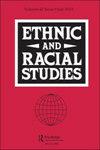移民身份和警察对低调的要求
IF 2
2区 社会学
Q1 ETHNIC STUDIES
引用次数: 0
摘要
随着学者对移民-犯罪悖论机制的探索,对移民行为的研究不断扩大。在定量研究中,一个重要但尚未开发的领域是低调行为。“低调”一词指的是移民和移民群体采取的一系列行为,以减少或减轻对各种风险环境和制度威胁的暴露,特别是警察。本研究利用来自德克萨斯州埃尔帕索县社区的数据,探讨了移民身份与社区低调行为之间的关系。埃尔帕索对历史上欢迎移民和移民群体的两国边境环境提供了独特的见解。结果表明,作为第一代移民,预示着邻居可能会对警察保持低调;然而,一旦考虑到文化和社区层面的因素,这种影响就减弱了。这些发现强调了低调行为对未来研究的重要性。关键词:移民;警察低调;移民与犯罪;移民经历;低调行为;伦理声明由于本文使用了二手数据,本研究获得了德克萨斯大学埃尔帕索分校机构审查委员会的豁免(研究编号1973835-1)。注1包含1.5代很重要,有两个重要原因使其与众不同。首先,这一分类取决于移民的年龄。正如Rumbaut (Citation2004)所描述的那样,这个称号经常被提供给小时候来到美国的移民。其次,在这个关键的发展阶段,移民与美国的文化适应有关,在我们的例子中,与那些成年后来到美国的人相比,可能会有所不同。他们在青春期前有机会体验他们的祖国,但仍然在他们仍在发育的时候移民,并忍受了一种独特的中间文化体验这项研究最初考虑了其他可能的相关因素,如西班牙裔、先前的受害者、对犯罪的感知和对美国的文化适应。然而,有几个原因从最终的分析中被删除了。首先,需要简化分析以允许更精简的模型。其次,根据因素的不同,存在概念/操作上的重叠。例如,虽然包括受访者的种族很重要,但78%的受访者是西班牙裔。考虑到研究地点和其他与结果更直接相关的因素(例如,对墨西哥人的文化适应,社区中的拉丁裔/非裔移民),我们选择删除它。本文章由计算机程序翻译,如有差异,请以英文原文为准。
Immigrant status and the desire for a low profile from police
ABSTRACTResearch into immigrant behaviors continues to expand as scholarship explores mechanisms surrounding the immigrant-crime paradox. An important and underexplored area in quantitative research surrounds low profile behaviors. The term “low profile” refers to a set of behaviors that immigrants and immigrant groups adopt to reduce or mitigate exposure to a variety of risky environments and institutional threats, particularly the police. This study explores the relationship between immigrant statuses and low profile behaviors in communities using data from El Paso County, Texas neighborhoods. El Paso offers unique insight into a binational border context that has historically welcomed immigrants and immigrant groups. The results suggest that being a first-generation immigrant predicts the belief that neighbors are likely to keep a low profile from the police; however, once culture and neighborhood-level factors are taken into consideration, this effect wanes. These findings emphasize the importance of low profile behaviors for future study.KEYWORDS: Immigrationlow profile from policeimmigration and crimeEl Pasoimmigrant experiencelow profile behaviors Disclosure statementNo potential conflict of interest was reported by the author(s).Ethics statementDue to the use of secondary data in this article, this study was granted exemption by the Institutional Review Board at The University of Texas at El Paso (study number 1973835-1).Notes1 The inclusion of 1.5-generation is important and distinguishes itself for two important reasons. First, this category depends on age of migration. As Rumbaut (Citation2004) described, often times this designation is provided to immigrants who came to the U.S. as children. Second, migration at this key developmental stage is relevant as acculturation to U.S., and in our case México, may vary somewhat compared to those who came as adults. They had the opportunity to experience their home country during pre-adolescence, but still migrated at a time where they were still developing and endured a unique in-between cultural experience.2 This study initially considered other possibly relevant factors such as Hispanic, prior victimization, perception of crime, and acculturation to the U.S. However, there are several reasons these were removed from the final analysis. First, there was a need to streamline the analysis to allow for a more parsimonious model. Second, there was conceptual/operational overlap depending on the factor. For example, while including the ethnicity of the respondent is important, 78 percent of the respondents are Hispanic. Given the locale of study and other factors more directly related to the outcome (e.g., enculturation to México, Latina/o immigrants in neighborhoods), we elected to remove it.
求助全文
通过发布文献求助,成功后即可免费获取论文全文。
去求助
来源期刊

Ethnic and Racial Studies
Multiple-
CiteScore
4.60
自引率
8.00%
发文量
258
期刊介绍:
Race, ethnicity and nationalism are at the heart of many of the major social and political issues in the present global environment. New antagonisms have emerged which require a rethinking of traditional theoretical and empirical perspectives. Ethnic and Racial Studies, published ten times a year, is the leading journal for the analysis of these issues throughout the world. The journal provides an interdisciplinary academic forum for the presentation of research and theoretical analysis, drawing on sociology, social policy, anthropology, political science, economics, geography, international relations, history, social psychology and cultural studies.
 求助内容:
求助内容: 应助结果提醒方式:
应助结果提醒方式:


